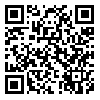BibTeX | RIS | EndNote | Medlars | ProCite | Reference Manager | RefWorks
Send citation to:
URL: http://jdisabilstud.org/article-1-3152-fa.html


 ، زهرا شعبانی*2
، زهرا شعبانی*2 

 ، سید موسی طباطبایی3
، سید موسی طباطبایی3 

 ، محبوبه طاهر4
، محبوبه طاهر4 


2- استادیار روانشناسی تربیتی گروه تعلیم و تربیت، پژوهشگاه مطالعات آموزش و پرورش، تهران، ایران
3- استادیار گروه علوم شناختی، دانشکدهٔ روانشناسی و علوم تربیتی، دانشگاه سمنان، سمنان، ایران
4- استادیار گروه روانشناسی، واحد شاهرود، دانشگاه آزاد اسلامی، شاهرود، ایران
چکیده
زمینه و هدف: باتوجه به تأثیر مهارتهای شناختی بر جنبههای مختلف هوش و برعکس، میتوان گفت که برخی از جنبههای هوش از مؤلفههای هیجان اندیشه تأثیر میپذیرد و با علائم نقص توجه/بیشفعالی رابطه دارد؛ بنابراین پژوهش حاضر با هدف تدوین الگوی نارسایی توجه نوجوانان مقطع (دورۀ) متوسطهٔ اول براساس پویایی و بیتابی روانی با میانجیگری هوش تجربی انجام شد.
روشبررسی: روش پژوهش حاضر از نوع همبستگی و بهطور ویژه تحلیل مسیر بود. نمونهٔ مطالعه را نوجوانان مبتلا به اختلال نارسایی توجه در دورهٔ متوسطهٔ اول شهر تهران در سال ۱۴۰۱-۱۴۰۰ تشکیل دادند که با استفاده از روش نمونهگیری خوشهای، دویست نفر از این دانشآموزان انتخاب شدند. ابزارهای جمعآوری دادهها، مقیاس نقص توجه/بیشفعالی بزرگسالان (سازمان بهداشت جهانی، ۲۰۰۵) و پرسشنامهٔ هیجان اندیشه (کاظمی حقیقی، ۱۳۸۹) و آزمون مکعبها (کهس، ۱۹۲۰) بود. تجزیهوتحلیل دادهها با استفاده از ضریب همبستگی پیرسون در نرمافزار SPSS نسخهٔ ۲۶ و تحلیل مسیر با نرمافزار AMOS نسخۀ ۲۴ صورت گرفت. سطح معناداری آزمونها در این پژوهش ۰٫۰۵ در نظر گرفته شد.
یافتهها: اثر مستقیم بیتابی روانی بر نارسایی توجه، مثبت و معنادار (۰٫۰۰۶=p، ۰٫۱۵=β) و بر هوش تجربی، منفی و معنادار (۰٫۰۰۱>p، ۰٫۳۷-=β) بود. اثر مستقیم پویایی بر هوش تجربی، مثبت و معنادار (۰٫۰۰۱>p، ۰٫۲۴=β) و اثر مستقیم هوش تجربی بر نارسایی توجه، منفی و معنادار (۰٫۰۰۱=p، ۰٫۴۹-=β) بود. اثر غیرمستقیم پویایی بر نارسایی توجه بهواسطهٔ هوش تجربی، منفی و معنادار (۰٫۰۰۴=p، ۰٫۱۱-=β) و اثر غیرمستقیم بیتابی روانی بر نارسایی توجه بهواسطهٔ هوش تجربی، مثبت و معنادار (۰٫۰۰۱=p، ۰٫۱۸=β) بود. شاخصهای نکویی برازش، برازش خوب مدل پیشنهادی را نشان دادند (۰٫۰۷۳=df/۲χ، ۰٫۰۰۱=RMSEA، ۰٫۹۹۹=IFI، ۰٫۹۹۸=NFI، ۰٫۹۹۹=CFI، ۰٫۹۹۸=GFI).
نتیجهگیری: براساس نتایج پژوهش حاضر، پویایی و بیتابی روانی ازطریق هوش تجربی، نارسایی توجه در نوجوانان را پیشبینی میکنند.
| بازنشر اطلاعات | |
 |
این مقاله تحت شرایط Creative Commons Attribution-NonCommercial 4.0 International License قابل بازنشر است. |


